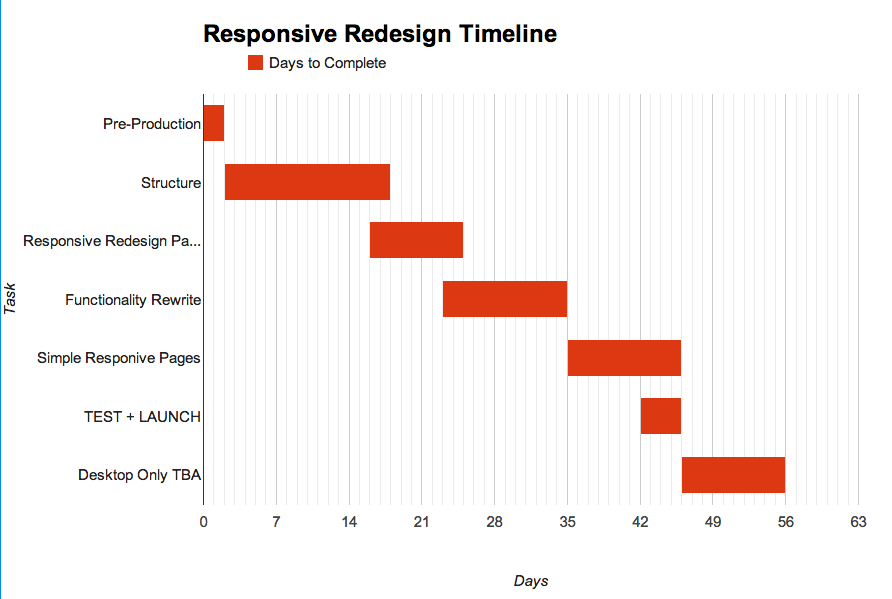We are frequently asked, How long does it take to make an app?
That’s not an easy question to answer because some apps are very simple and others very complex. Other factors like choice of platform, features, technologies, the customer’s budget and urgency also play a part. But, with over eight years of designing and developing of mobile apps, we can provide some rough benchmarks.
More importantly, our goal here is to help you understand everything that goes into the app production timeline, providing a platform with which you can begin research. If you are the one tasked to manage your business app’s development, this will prove very valuable to you.
Key Factors for Your App Timeline
- Time requirements are heavily influenced by your app’s complexity – the number of screens, features and especially anything “that’s never been done before.”
- When do you want to start? Being able to pay for development influences timelines – if you need to wait for your new fiscal year’s budget, or need to find investors, it’s best to ensure you will be able to cover the entire project. Stopping then starting again is a nightmare for all parties involved.
- You need to have a Project Coordinator available to answer questions from the development team and approve work as it reaches different stages.
- We advise sticking to a Minimum Viable Product for your first release – focus on core features and use customer data to drive decisions.
- Platform Choice – iOS, Android or Cross-Platform each has pros and cons.
- Will you need a Patent to protect any new technologies associated with your product?
- Additional time will be needed if you are developing software for hardware that is also under development.
- Avoid Feature Creep – adding features and functionality mid-way through development can be very costly and disrupt momentum.
App Time Requirements – Benchmarks
Any benchmark is a broad generalization in answering how long it takes to build an app. A more precise calculation, one that you can practically set your clock by, can only be done through a professional cost estimate. It defines everything that your app will require, screen-by-screen and feature-by-feature, providing a breakdown of each step by cost and time requirements. You might reference our companion article, The Cost to Develop an App, as it addresses many of the cost-related variables associated with app development.
The time needed to build an app starts only after you sign a contract with an agency and ends once the app becomes available for release. Development should continue after release to add features and improve its performance. Uber today has a very different, much more sophisticated app in all respects than the one they had in 2009-2010. Mark Zuckerberg was able to create the first version of Facebook in just two weeks back in 2004. If you are getting into Mobile, the public launch of your app is merely the beginning of your journey.
How Long Does It Take To Make an App
Generalized Time Requirements by App Complexity
| Screens | Time Requirements | |
| Simple App | 6 or fewer screens | 6 – 8 weeks |
| Average Interactive App | 12 screens | 5 – 6 months |
| Complex App | 24+ screens | 10 – 12 months |
The number of unique screens within the app is usually (but not always) indicative of an app’s complexity. It usually correlates to a number of individual parts that need to fit together. But, as discussed in the costs of an app, the introduction of very new technologies or creating features that have never been done before can dramatically increase time requirements. Even an app with six unique screens trying to do something completely new could take well over a year.
Looksery is a good example of a very new, arguably “never been done before” type of app for providing Real-Time Augmented Reality Video. We are proud to have been involved in the design work for Looksery. It’s not often that a startup launches and immediately “goes big” – Snapchat paid $150 million to acquire Looksery back in 2015.
Budgeting and Funding Factors
Tying in with the cost of an app are your means of paying for its development. This has a direct impact on how long it takes to make an app. This can depend on the nature, size and profitability of your business, suffice that it’s best to run through several scenarios:
Mid-sized businesses and enterprises are often regarded as having deep pockets – but getting anything except a few dollars for petty cash often requires approval from a department manager or an executive. It’s going to come out of their budget, however great or small that may be. Their budget may also be tied to the company’s fiscal year. When funds are available, development can start in earnest – suffice that your planning needs to take the approval process into account. That may depend on extra funds being available at the end of the year or having to wait until the new fiscal year.
Small to medium-sized businesses on a budget have a steady flow of money, but may not be able to afford full-scale development. In this case, your business negotiates a fixed amount of development work monthly until your app is completed. Most development agencies will be happy to negotiate terms with you, as this is a typical situation.
Startups and early-stage businesses have enough money to get started, but often do not have enough funds to cover the development of a full first-release version of their app. Instead, they need to use their first tranche of money to produce something they can use to go out and attract more money from investors. That’s likely to be a proof of concept or similar early-stage product. Finding investors and then actually being able to use their funds frequently involves several weeks or months, sometimes even a year or more. Then, with more money, development can continue to achieve a public launch. So, time to find investors needs to be considered in this scenario.
Your Role in Project Management
As the project owner, your engagement in the development process is also vital to your app development timeline. We discuss aspects of this in using Checklists for Better Project Management. Specifically:
You will need to designate someone from your business to be your project coordinator. Their role is to track progress and provide timely feedback, guidance, and decisions on the work of the agency you’ve hired.
It’s essential that someone be available throughout the entire development process to help maintain a continuous flow. As one item or feature is completed, the development team itself may not be able to move on to other work until you’ve approved what’s been done.
Your development agency will assign you an account manager. The account manager is there to answer your questions, keep an up-to-date calendar on what is being worked on and by whom, collects questions for you from our development and design team, and more. Their job is to make life easy for your project coordinator. As several months could be involved, it’s also worth appointing an assistant coordinator to cover sick days and vacation time.
Using a Gantt Chart for Timelines
Your business or your mobile agency will likely have project management software for tracking deliverables by dates due. The software is likely to go into a lot of detail on the scheduling – like lots of small tasks. That could be more detail than you need. The software should also provide a quick snapshot of the production timeline, probably with a Gantt Chart like the one below. When you first walk into the office, still on your first cup of coffee – it’s nice to have something “easy on the eye” to advise or remind you of what’s being worked on and what’s coming next:

A Gantt Chart like this can help show how long it takes to make an app.
MVP – Tackling the Toughest Questions First
Per Wikipedia, “A minimum viable product (MVP) is a product with just enough features to satisfy early customers and to provide feedback for future product development.” An MVP inherently focuses on the core features not just why anyone would want to use your app, but actually LOVE to use your app. That gets to the very soul of your app and the one thing you want it to do best – better than anything else in the app stores or the broader market.
Anything that does not go into supporting its core functionality and ability to generate customer feedback or app usage data, detracts from the MVP’s objective. The whole idea of “fail fast and frequently” is commonly associated with MVPs – but the real goal is to fail fast, frequently and at a cost that doesn’t hurt. This demands asking all of the tough questions first, starting with:
- Do customers like it?
- Will they pay for it?
- How much will they pay for it?
We cover MVPs in more detail in Understanding Your Minimum Viable Product and more of its advantages in Why Startups Fail – A Matter of Process? The key point of an MVP is to stick only to essential features unless and until the data and customer feedback you receive advocates differently. In that way, you save time and money on features and functions customers don’t use, don’t want or that simply complicate your ability to gather feedback on core features.
iOS and Android or Cross-Platform?
Your choice of platform can impact how long it takes to make an app, too. It used to be that developing an app for Android took longer than one for Apple or iOS devices – owing to the sheer number of different Android devices. The difference is decreasing gradually, but steadily. Presently, Android involves about 10-15% more overhead time.
Cross-Platform Mobile Development – Pros and Cons provides a deeper explanation from both a technical and marketing perspective for launching an iOS or Android version first, or why you might choose a cross-platform solution. A cross-platform approach will make your app available to both operating systems at a lower cost than producing both an iOS and Android version. However, you can expect it take roughly 50% longer to develop and up to 300% longer to debug. There are pros and cons with each approach, so you research your options and talk with your development agency before locking in a decision.
Do You Need Patent Protection Before Your Public Launch?
If you intend to produce an app making use of completely new technologies, you may consider not publicly releasing your app until it is protected by a patent. We cover these and related issues in How to Patent an App. Conversely, provided you do your due diligence in conducting a patent search, filing a provisional patent application will enable you to use “Patent Pending” on your app. “Patent Pending” signifying to others that you are seeking legal protection over your intellectual property. It’s only good for one year. The patent issue is not really a part of the time required to produce your app, but it can impact your timeline so you need to be aware of it.
Parallel Development of Hardware and Software
Many mobile and Internet of Things applications undergo development even while their associated hardware is still being worked on. Very frequently, a change in hardware will require changes in the software, too. Even so, large portions of the app’s development and design are likely to remain the same throughout – and thus save time compared to developing sequentially. That’s pretty common today especially when being first to market can help a company achieve an almost insurmountable lead over competitors, like Amazon’s Alexa-based units did compared to Google’s Home Assistant until this year. The point here is that you’ll need to factor in additional development time even after your hardware reaches its final state.
Mission and Feature Creep
Adhering to the process and principles of an MVP requires a lot of discipline. All too often project owners will want to add more features as they see their app taking shape. Most MVP-aligned development agencies will advise against that – for the greater good of the project owner. When these changes and additions are implemented in the last half or even last minute, the costs will be far greater and will take longer than if they were planned from the beginning.
Final Notes
Understanding everything that can impact your app’s public release date will prove far more useful than broad generalizations. When it comes down to it, you have a large amount of control over how fast your app can be produced, subject only to the skill and resources of your developer. That brings us to how do you choose a developer? There’s a clearly defined process for that which involves doing some research to create a shortlist. We provide you a useful process for creating a shortlist of developers in How to Choose the Perfect Mobile Agency for your project.
Have any questions? We’d love to hear them – just message us directly via our contact page or give us a shout on Twitter!






Leave a Reply